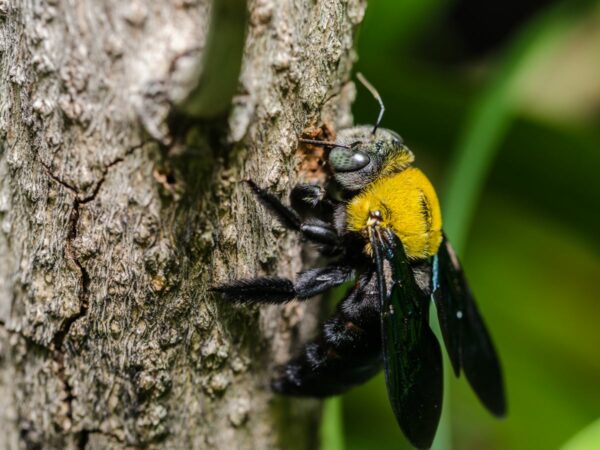Carpenter Bee Removal Morristown, NJ
In the late-spring and early summer, homeowners often notice large, black bees hovering around the outside of their homes. These are carpenter bees searching for mates and favorable sites to construct their nests. Male carpenter bees are quite aggressive, often hovering in front of people who are around the nests. The males are quite harmless, however, since they lack stingers. Female carpenter bees can inflict a painful sting but seldom will unless they are handled or molested.
Carpenter bees resemble bumble bees, but the upper surface of their abdomen is bare and shiny black; bumble bees have a hairy abdomen with at least some yellow markings.
Despite their similar appearance, the nesting habits of the two types of bees are quite different. Bumble bees usually nest in the ground whereas carpenter bees tunnel into wood to lay their eggs. Bare, unpainted or weathered softwoods are preferred, especially redwood, cedar, cypress and pine. Painted or pressure-treated wood is much less susceptible to attack. Common nesting sites include eaves, window trim, facia boards, siding, wooden shakes, decks and outdoor furniture.

Carpenter Bee Control New Jersey
 Entrance holes are perfectly round.
Entrance holes are perfectly round.
Carpenter bees overwinter as adults in wood within abandoned nest tunnels. They emerge in the spring, usually in April or May. After mating, the fertilized females excavate tunnels in wood and lay their eggs within a series of small cells. The cells are provisioned with a ball of pollen on which the larvae feed, emerging as adults in late summer. The entrance hole and tunnels are perfectly round and about the diameter of your finger. Coarse sawdust the color of fresh cut wood will often be present beneath the entry hole, and burrowing sounds may be heard from within the wood. Female carpenter bees may excavate new tunnels for egglaying, or enlarge and reuse old ones. The extent of damage to wood which has been utilized for nesting year after year may be considerable.
Control
Carpenter bees prefer to attack wood which is bare, weathered and unpainted. Therefore, the best way to deter the bees is to paint all exposed wood surfaces, especially those which have a history of being attacked. Wood stains and preservatives are less reliable than painting, but will provide some degree of repellancy versus bare wood. To further discourage nesting, garages and outbuildings should be kept closed when carpenter bees are actively searching for nesting sites.
Although carpenter bees are less aggressive than wasps, female bees provisioning their nests will sting.
